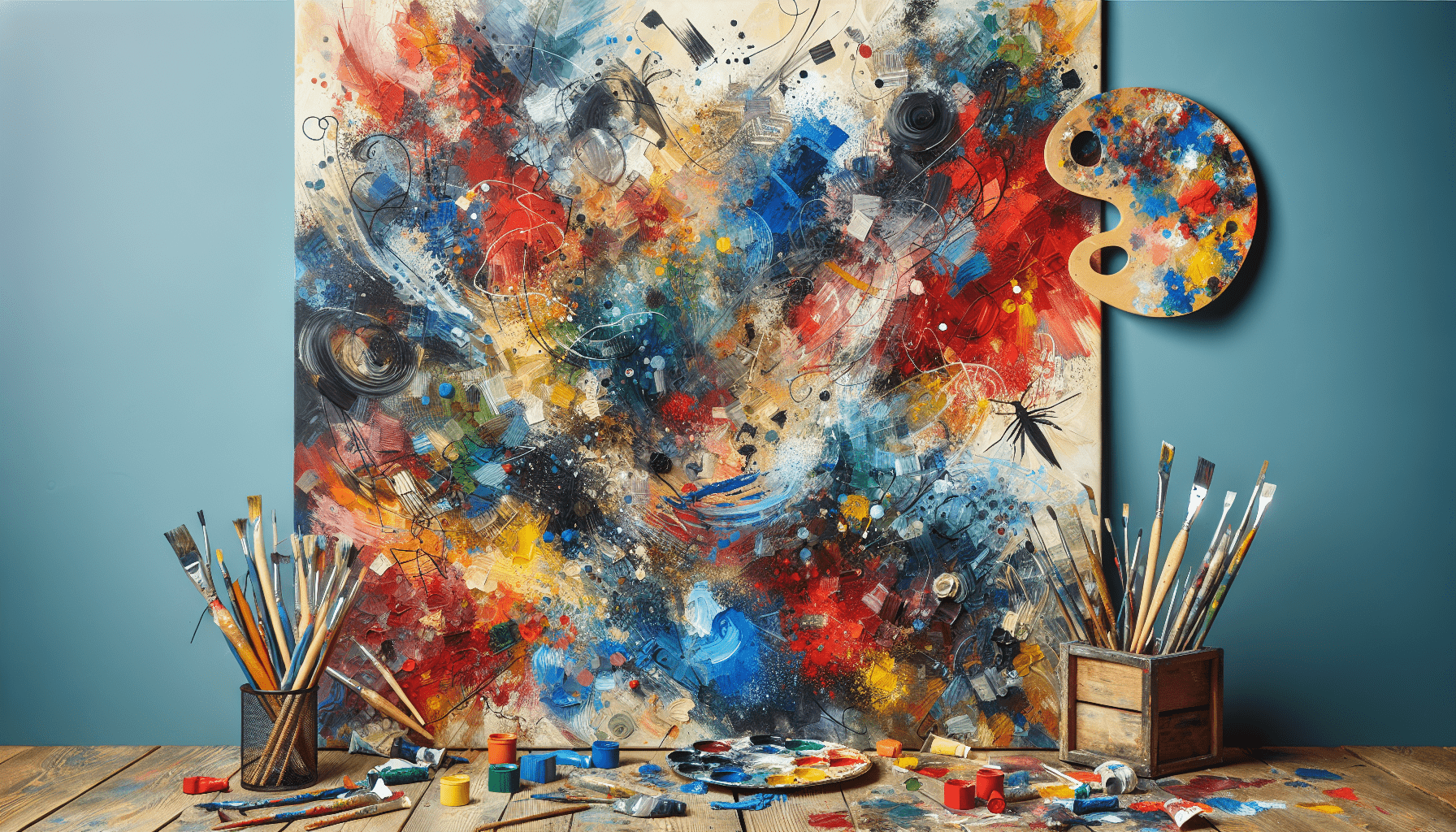The Joy of Abstract Painting
When you think about paintings, you might imagine detailed images or perfectly blended colors. However, abstract painting invites you to step into a liberating space where expression takes precedence over technical skill. This form of art opens up pathways to communicate emotions, ideas, and experiences without the constraints of representational form.
Understanding Abstract Art
What is Abstract Art?
Abstract art is a departure from reality. Instead of portraying recognizable subjects, it emphasizes shapes, colors, and forms. By stripping away literal representation, artists can express feelings and concepts more freely. In abstract painting, you aren’t bound by the “rules” of traditional art. Each stroke can represent a mood, each color a different emotion.
The Emotional Connection
Creating abstract art is an emotional journey. It allows you to tap into your feelings and express them in a visual format. You may find that certain colors resonate with your current mood, while specific shapes may reflect your thoughts. Engaging with abstract art can also evoke emotions in viewers, creating a dialogue without spoken words.
The Importance of Expression Over Perfection
Letting Go of Expectation
One of the most liberating aspects of abstract painting is the ability to let go of perfectionism. Instead of aiming to replicate reality, focus on the emotions and feelings you want to convey. The process becomes more about personal expression than technical precision. This shift in mindset can free you to experiment and play without fear of failure.
Celebrating Imperfections
In the world of abstract art, imperfections are not shortcomings but rather unique characteristics that add to the piece’s charm. Every accidental splash of paint and misaligned stroke tells a story. Embracing these flaws encourages authenticity and personal expression that can resonate on a deeper level with both you and your viewers.
Getting Started with Abstract Painting
Gathering Your Materials
Before you jump into the creative process, it’s essential to gather the right materials. Here’s a simple list to help you get started:
| Material | Purpose |
|---|---|
| Canvas or Paper | Your primary workspace for painting. |
| Acrylic Paint | Easy to work with and dries quickly. |
| Brushes | Different sizes for various effects. |
| Palette Knives | Great for creating texture and mixing colors. |
| Sponges | Excellent for applying paint in unique ways. |
| Water Cups | To rinse brushes and thin paint. |
| Rags or Paper Towels | For cleaning and experimentation. |
By having these materials on hand, you’re ready to embrace the spontaneity that abstract art offers.
Choosing Your Painting Space
Find a comfortable space where you feel free to express yourself. A well-lit area with enough room will allow you to move around and explore without feeling constrained. You might notice that your environment can influence your mood and creativity, so consider choosing music or scents that inspire you and make you feel at ease.
Exercises to Enhance Your Creation
Freeform Shapes
One of the best ways to start is by experimenting with freeform shapes. Begin with a blank canvas and use different brushes to create shapes without any specific goal in mind.
- Take a deep breath. Let go of expectations.
- Start with simple lines. Move your brush freely across the canvas.
- Add shapes and colors. Experiment with vibrant colors that resonate with you.
This exercise allows your intuition to guide you, fostering a sense of freedom in your creative process.
Splattering Paint
Another exciting technique to try is splattering paint. This method encourages spontaneity and can result in dynamic patterns.
- Choose your colors. Select a few hues that speak to you.
- Prepare your canvas. Place it on the ground or a flat surface where splatters are acceptable.
- Use your brush to flick. Dip your brush in the paint and flick it onto the canvas to create splash patterns.
This method can be incredibly exhilarating, allowing color and chaos to intertwine on your canvas.
Unique Tools for Creative Texture
Sometimes, using unconventional tools can lead to remarkable results. Consider using palette knives, sponges, or even your fingers to apply paint.
| Tool | Technique |
|---|---|
| Palette Knife | Create texture and sharp lines. |
| Sponge | Apply soft, blended colors and textures. |
| Fingers | Incorporate tactile experiences into your art. |
Experimenting with these tools will encourage you to think outside the box and develop your unique style.
Finding Your Style
As you engage in abstract painting, you may begin to discover what resonates with you. Your style will evolve based on your emotions, experiences, and preferences.
Reflecting on Your Works
Once you’ve created a few pieces, take some time to reflect. Look at your paintings and ask yourself what feelings they evoke.
- What colors did you choose?
- What shapes or patterns dominate your work?
- How do you feel when you observe your pieces?
This reflective process can help you understand your artistic voice and guide your future creations.
Seeking Inspiration
Inspiration can come from numerous sources, including nature, music, and personal experiences.
- Nature: Observe colors and shapes in your surroundings. What hues catch your eye?
- Music: Listen to different genres and let the rhythm inspire your painting style.
- Personal Experiences: Reflect on moments in your life that evoke strong emotions and transform them into visuals.
By being receptive to inspiration, you will find new ideas to infuse into your art.
Overcoming Creative Blocks
Embracing the Uncomfortable
As you begin your journey, you might encounter a creative block. This is common and can often feel discouraging. When it happens, remind yourself that art is meant to be a fluid expression of your feelings. Embrace the discomfort, and use it as fuel for creating.
- Take a break: Step back from your work for a moment to clear your mind.
- Experiment: Try new techniques or tools you’ve never used.
- Collaborate: Painting alongside friends can reignite your passion for creativity.
Releasing Judgment
Letting go of self-judgment is crucial in your artistic journey. When you create, do so without critiquing your work. Remember that abstract art is subjective, and what matters most is your emotional expression.
Connecting with Other Artists
Joining a Community
Being part of a creative community can enhance your artistic experience. Whether it’s through local art groups, online forums, or social media platforms, connecting with like-minded individuals allows for the exchange of ideas, techniques, and encouragement.
- Engage in discussions. Share your work and receive constructive feedback.
- Attend workshops. Participate in collaborative sessions to learn from others.
- Visit galleries or exhibitions. Surround yourself with art to inspire your creativity.
These connections can provide motivation and support, keeping your passion for abstract painting strong.
Sharing Your Art
Don’t hesitate to share your artwork with others. Consider creating an online portfolio or using social media to showcase your creations. Engaging with an audience can be rewarding and might open doors to new opportunities.
- Post images of your work. Include captions that describe your creative process.
- Engage with comments. Respond to feedback from viewers and build relationships.
Sharing can help solidify your identity as an artist while inviting others into your world of expression.
The Continuing Journey of Abstract Painting
The Evolution of Your Style
As you practice, you may notice your style evolving. Embrace this change as part of the artistic journey. Your preferences in color, texture, and technique will likely shift as you gain experience and discover yourself more deeply.
Setting New Goals
Setting goals can provide direction for your creative journey. Whether you want to experiment with new techniques or explore specific themes, having clear intentions can inspire you to keep moving forward.
- Define your focus: Identify areas you want to explore further.
- Create small projects: Set manageable tasks that fit your goals.
- Review and adjust: Regularly assess your progress and be ready to shift your focus if needed.
Lifelong Learning
Art is a continual learning journey. Always be open to trying new methods, learning from mistakes, and evolving your approach. The more you embrace this mindset, the richer your artistic experience will be.
Your commitment to growth will fuel your creativity and lead to profound self-expression through abstract painting.
The Benefits of Abstract Painting
Stress Relief and Mental Well-Being
Engaging in abstract painting can significantly improve mental well-being. Creating art serves as a powerful outlet for emotions and can act as a stress reliever. By focusing on the act of painting, you divert attention from daily pressures, helping to alleviate anxiety.
Boosting Creativity
Regular practice enhances your creative thinking and problem-solving skills. As you embrace abstraction, you learn to approach challenges with flexibility and innovation, which can overflow into other areas of your life.
Building Confidence
Finally, as you develop your skills and discover your voice, you’ll find your confidence as an artist growing. Each painting becomes a testament to your journey and a source of pride as you embrace your unique perspective.
Taking the Next Steps
Committing to a Practice
To truly benefit from abstract painting, consider making it a regular practice. Set aside dedicated time each week to create, reflect, and grow as an artist. This commitment will help you cultivate your skills and deepen your understanding of your artistic self.
Never Stop Creating
The beauty of abstract painting is that there’s always room for experimentation and discovery. Whether you create every day or once a week, the key is to keep producing work. Remember, the journey is just as important as the outcome, and every creation contributes to your evolution as an artist.
By embracing expression over perfection, you will flourish in your abstract painting journey. So grab your materials, and allow your feelings to guide your hand. Your artistic self is waiting to emerge!


Leave a Reply